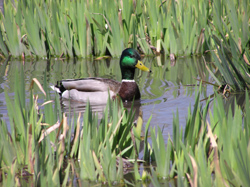About Wetlands
 Wetlands ~ A Definition:
Wetlands ~ A Definition:
The definition of a wetland is a tricky subject. Generally, wetlands are areas that contain three components: the presence of water, special soils (hydric or water-loving) and water tolerant plants. The interactions of these three characteristics are what make different types of wetlands distinct from one another. Examples of wetlands in Montana are marshes, prairie potholes and wet meadows.
The Importance of Wetlands:
Less than 1% of Montana is comprised of wetlands (3% of Montana is riparian habitat), yet 50% of bird species depend on these important areas. In addition to being critical habitat for birds and other wildlife, wetlands assist in water purification and flood control.
In the prarie pothole region of northeast Montana, for instance, over 225 species of birds use these declining wetland areas for nesting. Included in this number are piping plover and bald eagle.
These areas are also of critical importance to several endangered species during migration, including the whooping crane, interior least tern and peregrine falcon.
Wetland areas adjacent to rivers act like a sponge to absorb water during spring runoff, capturing the water and releasing it later in the year. This not only reduces the damage of flooding, but also reduces erosion. plains cottonwood lead.
 The Importance of Cottonwoods:
The Importance of Cottonwoods:
Cottonwood forests provide habitat for more than half the bird species in Montana, while hundreds of thousands of spring and fall migrating birds seek these riparian corridors for food and shelter.
 The Decline of Wetlands:
The Decline of Wetlands:
It is estimated that over 50% of the wetland areas in the U.S. have disappeared in the past 200 years and National Audubon Society estimates that over 100,000 acres of American wetlands continue to be destroyed annually. Montana can then consider itself fortunate to still have over 70% of its historical wetlands intact. Compare this to some of our neighbors (South Dakota 65%, Wyoming 62%, North Dakota 50%, Idaho 44%), and the value of Montana’s remaining wetlands in obvious and crucial.
For many years wetlands were thought of as a waste of productive land. They were filled or drained for crops or buildings. As with so many native habitats, we didn’t realize how important these areas were until their disappearance became critical.
Section 404 of the Clean Water Act was created to help protect wetlands. Under this section it is unlawful to discharge dredged or fill materials into the waters of the United States without receiving authorization (known as a 404 permit) from the Army Corps of Engineers. However, the Corps has a history of approving nearly all 404 permit applications, which nullifies any protection offered by the Clean Water Act.
 The Future of Wetlands:
The Future of Wetlands:
Perhaps more than any other issue, the protection and survival of wetlands in Montana depends on grassroots involvement.
Landowners have begun to recognize the value of wetlands and their contribution to the quality of life on the farm and ranch. These landowners are either protecting existing wetlands on their property or restoring historical wetlands through one of a variety of wetlands restoration programs.
Local community organizations are also becoming involved in this important conservation topic. Montana Audubon has teamed with several other non-profit and government organizations to begin mapping the wetlands of the Helena Valley. This two year project will gather a baseline inventory of Helena area wetlands. This data may then be used to avoid the development of wetlands, to assist planners with open space decisions, provide historic information for restoration projects, and can hopefully be used as a model for other communities interested in mapping the wetlands in their area.
 Wetlands can be artificially created. A “no net loss” program was instated in 1989, with a component of the program being the recreating and restoring of wetland areas to mitigate losses elsewhere. However, when this program is utilized, it is necessary to create at least 2 acres of wetland for every lost acre as the ecological effectiveness of artificial wetlands is in question for many areas.
Wetlands can be artificially created. A “no net loss” program was instated in 1989, with a component of the program being the recreating and restoring of wetland areas to mitigate losses elsewhere. However, when this program is utilized, it is necessary to create at least 2 acres of wetland for every lost acre as the ecological effectiveness of artificial wetlands is in question for many areas.
Wetlands are crucial habitat for many species, includinghumans. As these areas are filled or drained, we lose land that is critically important to water filtration, flood control and wildlife survival.
Things we can do to conserve wetlands:
- Hold developers and planning boards to the highest possible standard when it comes to wetland preservation. Unplanned and unchecked growth is a major contributor to wetland destruction.
- Watch closely any proposed wetland degradation that comes under the scope of the Army Corps of Engineers. It has been found in some areas that the Corps approves over 99% of 404 permit applications, which give authorization to alter or destroy wetland areas.
- Encourage preservation or restoration of wetlands on private land. There are even some programs that offer financial reimbursement for agricultural value in addition to paying the majority of restoration costs to landowners who protect wetlands on their property.
- Get involved in your area. Locally developed solutions are always better than any mandated protection or more regulation. Landowners, grassroots organizations, local government agencies and citizens working cooperatively can make wetland preservation truly a community priority.